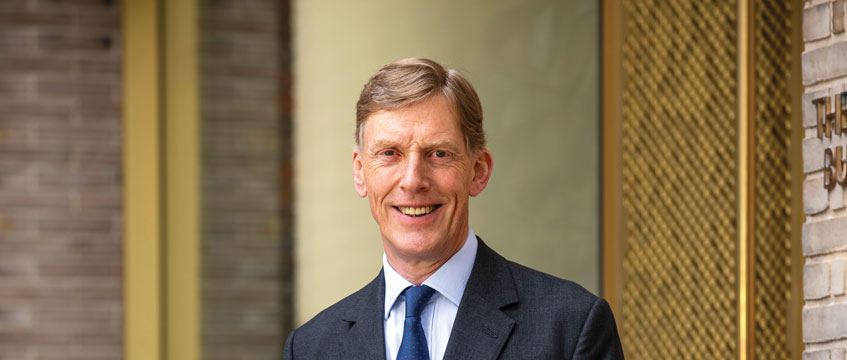Refurb or rebuild? Gerald Kaye reveals Helical’s winning formula
When Helical chief executive Gerald Kaye wrote the business plan for the Bower development next to Old Street Roundabout, EC1, he gave it the title “Less is more”.
The “grandiose” redevelopment scheme proposed by the previous owner was dropped. “I just thought, this is bonkers because you have got some perfectly convertible 1960s buildings,” says Kaye.
The structure and foundations of the two buildings were used in Helical’s 320,000 sq ft AHMM-designed scheme, completed in 2018.
When Helical chief executive Gerald Kaye wrote the business plan for the Bower development next to Old Street Roundabout, EC1, he gave it the title “Less is more”.
The “grandiose” redevelopment scheme proposed by the previous owner was dropped. “I just thought, this is bonkers because you have got some perfectly convertible 1960s buildings,” says Kaye.
The structure and foundations of the two buildings were used in Helical’s 320,000 sq ft AHMM-designed scheme, completed in 2018.
Reducing carbon
It saved 12,493 tonnes of carbon by adopting a refurbishment and remodelling strategy rather than demolishing and rebuilding. Floors were added to both buildings as well as space on the sides. “The structural engineers did a good job,” says Kaye, who started out as a graduate surveyor in 1979.
“One can take just as much pride and enjoyment from a refurbishment as from a new building – perhaps more because the challenges are greater.”
Refurbishment and remodelling have proven to be a winning formula here and at other Helical projects, driven by business sense before embodied carbon was on the agenda. When Helical bought Rex House on Regent Street in the late 1990s, it dropped the proposed redevelopment scheme in favour of a refurb. “It is a perfectly good building,” says Kaye.
However, at the company’s latest project, 100 New Bridge Street, EC4, Helical again proposes to carry out a refurbishment which will have less impact on the environment than a new-build scheme.
Sustainability
A comparison with its new-build JJ Mack Building, EC1 – Helical’s most sustainable office to-date, with BREEAM Outstanding and NABERS five-star ratings, built on a site where a poor-quality post-war building was demolished for Crossrail – neatly illustrates the difference in carbon terms.
The embodied carbon for the 200,000 sq ft JJ Mack Building was clawed back to 816kg CO2E per sq m from an initial projection of 1,036kg through several steps, including using UK steel, Earth-friendly concrete and minimising construction waste.
At 100 New Bridge Street, where Helical will add a 40,000 sq ft 10th floor to the 170,000 sq ft building, and reuse 85% of the existing structure, Kaye says the embodied carbon figure is going to be below 500kg CO2E per sq m. It may edge closer to 400kg through recycling materials.
“That’s quite a good yardstick of what one is saving. If you can keep a significant amount of the existing building, you are going to save about half the carbon,” he says. “You are about 50% ahead of the game by reusing the foundations.”
Future of the market
He expects the market will increasingly be refurbishing and remodelling buildings which were put up in the 1980s onwards as “bones are good enough and a lot of them more or less maxed-out what they could put on the site”. Stanhope’s newly started refurbishment of Woolgate Exchange, EC2, developed by MEPC in 2000, is another example.
For Kaye, it is all about striking a balance. If you can refurbish and reuse, then you should, but it cannot be the only answer.
“We cannot move forward as an economy if everything has to be refurbished, because we would not be able to increase the amount of floorspace that is available,” he says.
Putting environmental considerations to one side, it is the numbers that must stack up. “If the building is adaptable, then to justify knocking it down you have to at least double it to make the numbers work, because of the extra time and cost involved in demolishing it, digging out the foundations, putting in new foundations and rebuilding it. It takes a lot longer to do that than if you are just doing a refurb.
“The bones of the building at 100 New Bridge Street are good, so there is absolutely no need to knock it down. The amount of extra space we are adding is not huge and therefore the structure takes it. But if you were going to put double the amount of space on the building then the existing structure would not take it and you would have to demolish it. For all the big towers in the city, you have to begin again. And those towers are needed,” he says.
Trans-Pacific Partnership
He cites the recent news that the UK will join the Comprehensive and Progressive Agreement for Trans-Pacific Partnership – a free-trade agreement between 11 countries around the Pacific Rim – as a positive headwind for the London office market.
“That’s going to be great for the economy going forward and one of the main things we are going to be selling into that group is services – which are going to be done from offices,” he says.
“London is a growing city, and the hub of the business community is still central London.”
When it comes to the Marks & Spencer site on Oxford Street, W1, Kaye has no qualms about saying that demolition and rebuild is the right answer for the Edwardian block. Walking past the site recently, he stopped to look at it.
“My thought was this: if M&S and the other landowners are prepared to provide a high-quality new building, which will have quite a large element of offices, then stopping them from doing that to keep the appalling collection of buildings that is there now would be taking it too far.
“If somebody is prepared to invest that much money in Oxford Street, they should be welcomed with open arms. Multi-floor retailing and department stores are not doing very well – there are not many of them left – and Oxford Street is going to be quite a big office location as these big stores get turned into offices.”
Some can be kept and remodelled, but others can’t due to columns and floor to ceiling heights.
“You can’t preserve everything in aspic,” Kaye says. “We are not going to decarbonise the world unless we have a strong economy. The only way we are going to improve things is if there is enough investment around to support new technologies and new infrastructure. Real estate has a role to play in that and we are doing some very good things by creating buildings which are much more efficient and higher quality.”
To send feedback, e-mail julia.cahill@eg.co.uk or tweet @EGJuliaC or @EGPropertyNews











